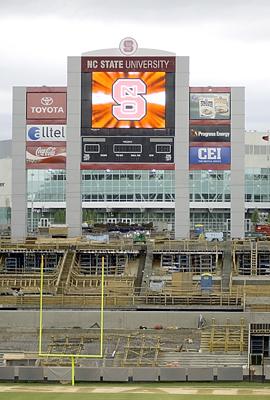
Nick Pironio
On a cool and rainy spring afternoon, more had changed at Carter-Finley Stadium than the players that make up N.C. State’s defensive line.
As the players took the field for the final spring football scrimmage in front of a bunched-up crowd on Saturday, a long-standing piece of the landscape in the North End Zone was missing — A.E. Finley Fieldhouse.
The fieldhouse was taken down shortly after the end of the 2006 season to make way for 7,100 permanent seats, a section known as “The Red Zone.”
“It’s pretty good to see, you know, everything’s coming together,” redshirt senior kicker and punter John Deraney said.
When Deraney joined the team in the fall of 2002, the old fieldhouse was still a fixture.
The stadium’s video scoreboard, which debuted in 2001, was still fairly new, and the Murphy Center — the team’s 103,254-square-foot fieldhouse of the future was still not finished. The Vaughan Towers, which now house luxury suites and a press box, were still simply plans.
Derek Medlin, a sophomore in history education, said the latest project at the stadium makes sense.
“It’s gone right in with every other expansion since Chuck Amato’s got[ten] here. It’s just kind of one after another,” Medlin said. “And it just seems like it’s the right place, right time.”
While Medlin said in some ways didn’t want to see the old field house go, he said the expansion of the stadium is a positive thing.
“It kind of takes a way a little bit of the tradition of the old field house, but I think it’s good to have those seats,” Medlin said. “I actually got some seats in the end zone.”
Meanwhile, Scott Lindsay, a freshman in mechanical engineering, said having a stadium closed in with seats in both end zones is the way to go in college football.
“It’s good because most of the major colleges have bowl stadiums,” Lindsay said.
Maribeth Bunting, a University Ambassador for football recruiting and sophomore in communication, said the additional seats could impact not only fans, but also that the addition could motivate players by allowing more fans to come to games.
Bunting also said she hoped the closed-in end zone would make for a louder environment at games.
“I hope so. That’d be neat, make it a better atmosphere, make it more into a football school,” Bunting said.
Coach Chuck Amato said after the scrimmage that he is encouraged to see the progress of the construction.
“It feels good. It’s come a long way since the last time you people were here when Finley Field House was there,” Amato said. “And now it’s there no longer, and that will be done by the time the season starts.”
Amato was quick to point out, though, that construction alone will not build his program up to where he wants it.
“Brick and mortar doesn’t bring in 25 All-Americans just because you’ve got it — because everybody else has it,” Amato said. “Everybody else has it, so it’s all a work in progress — and we’re right on course.”